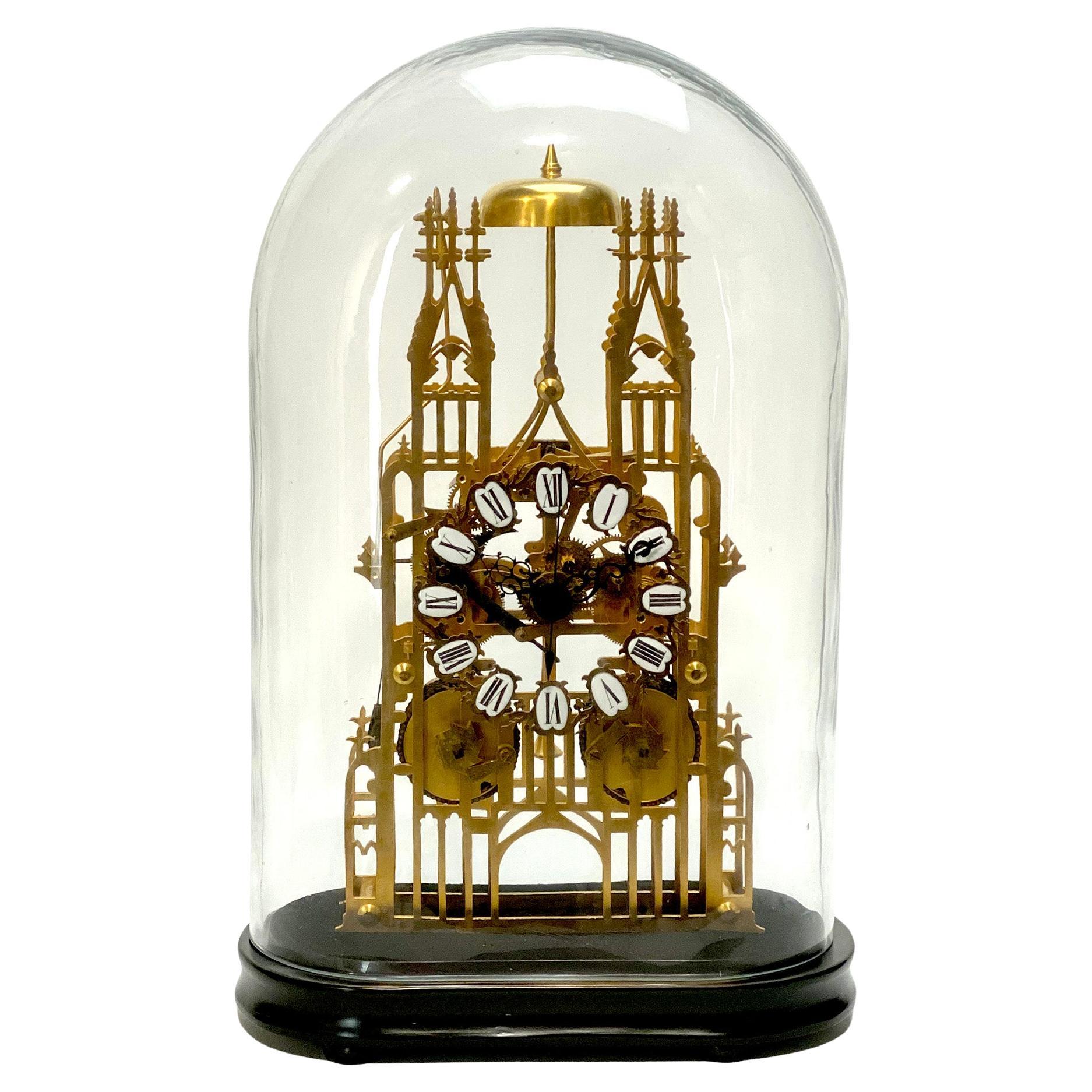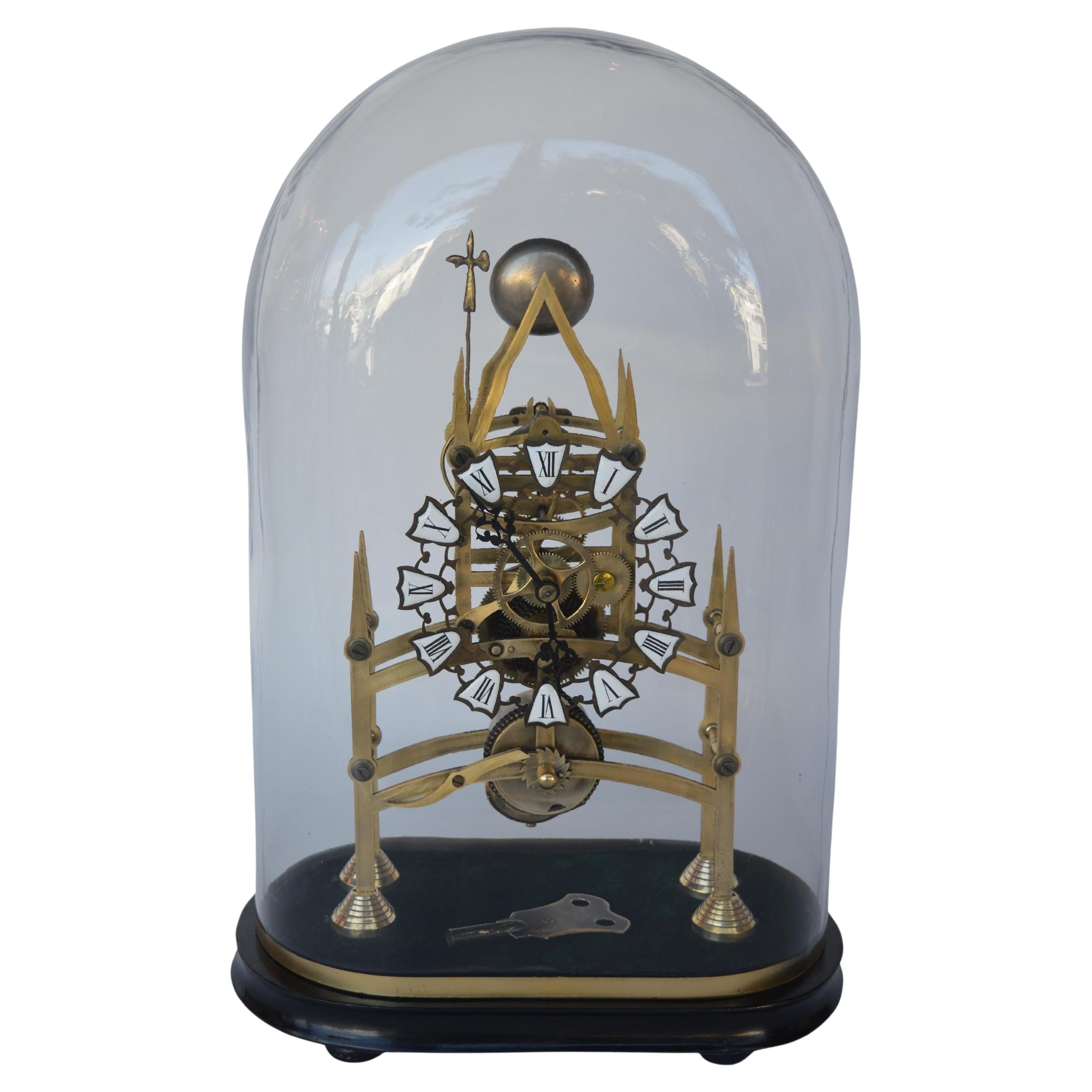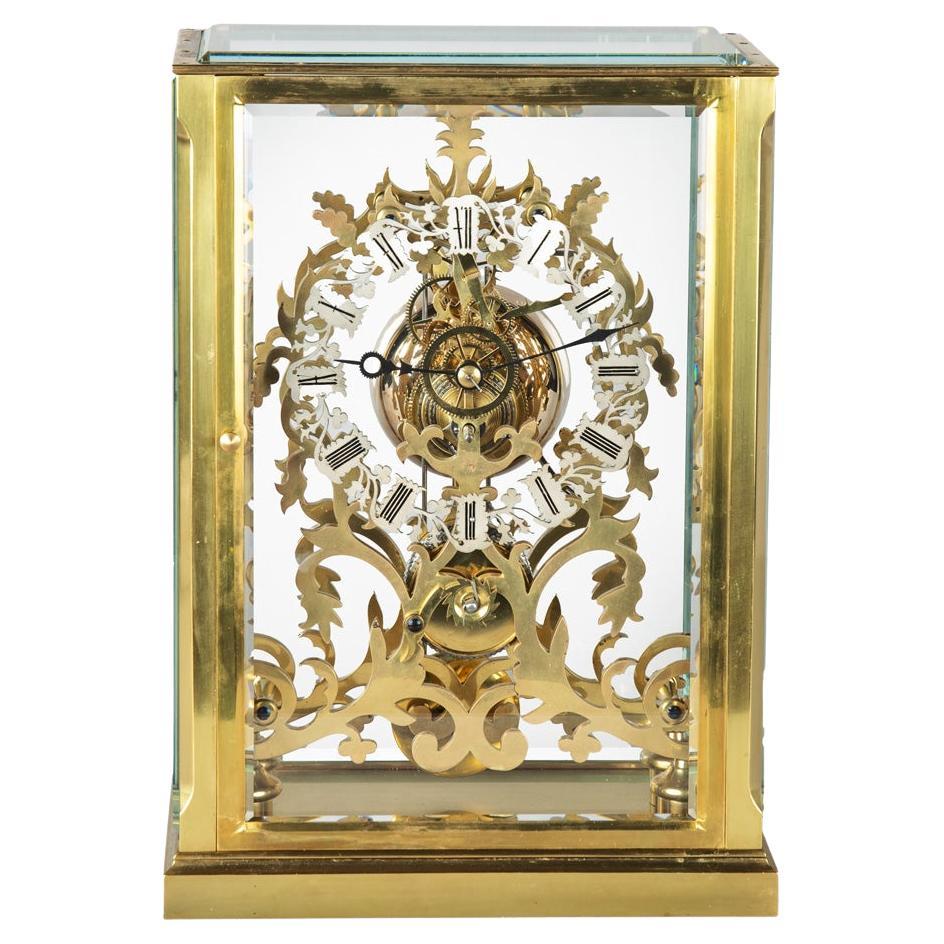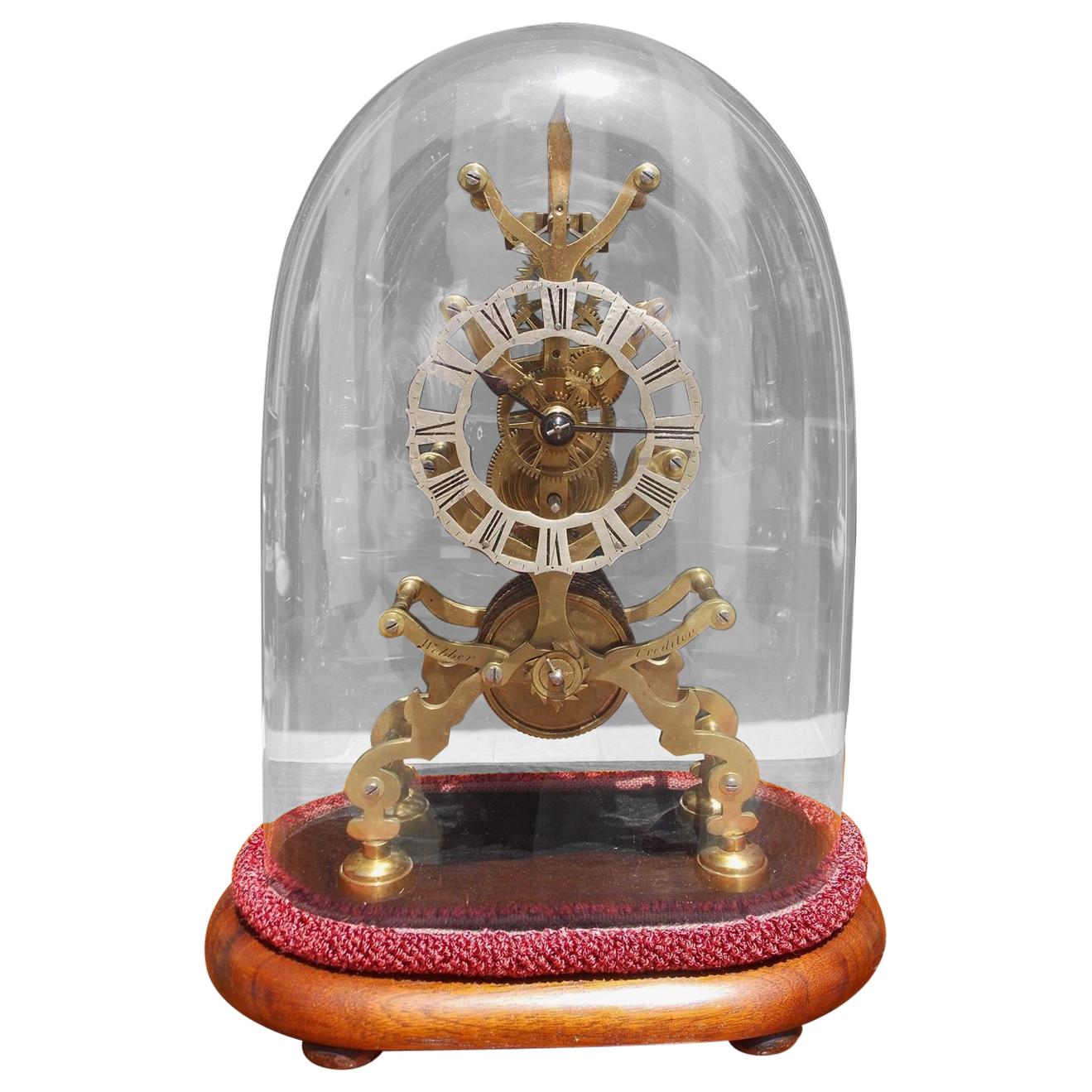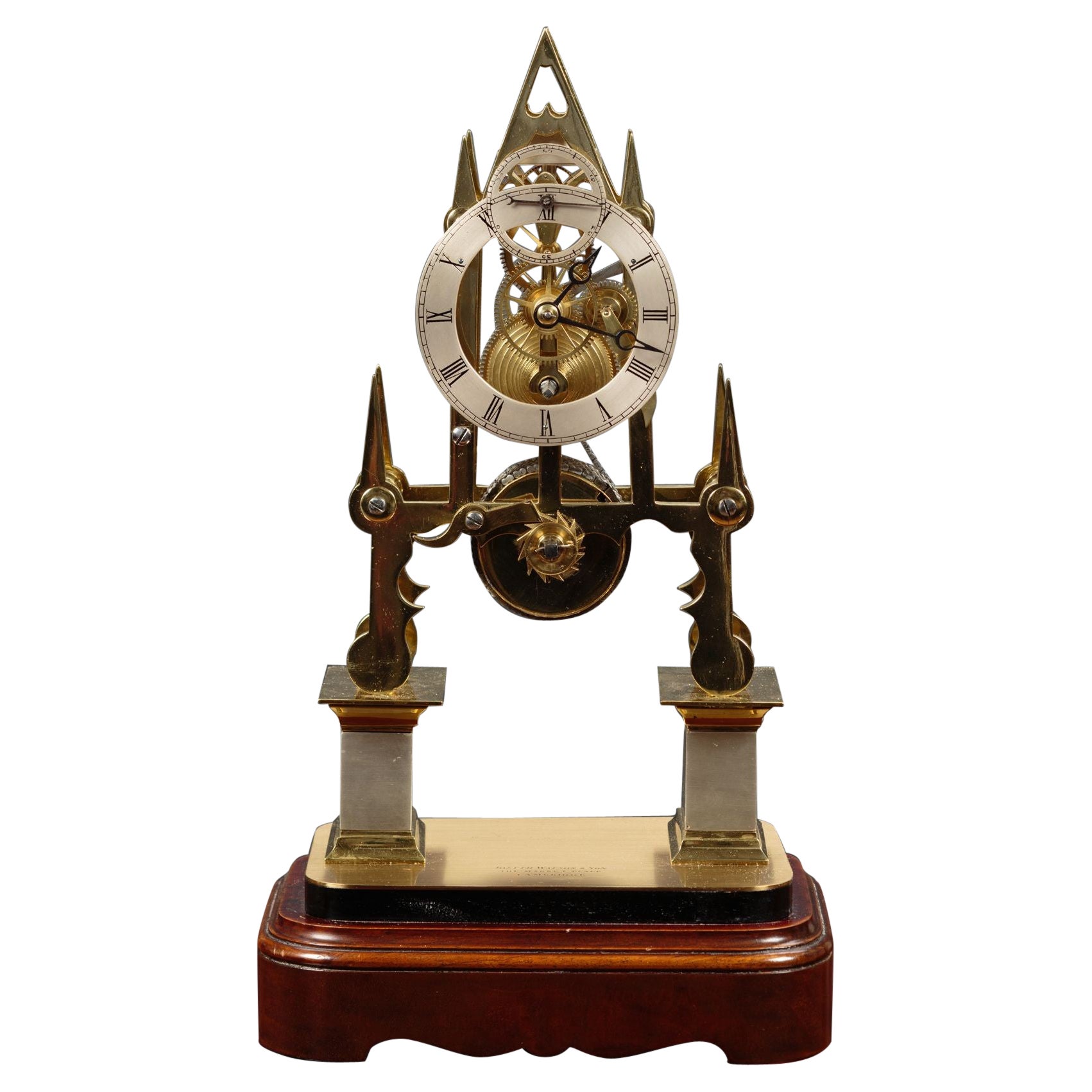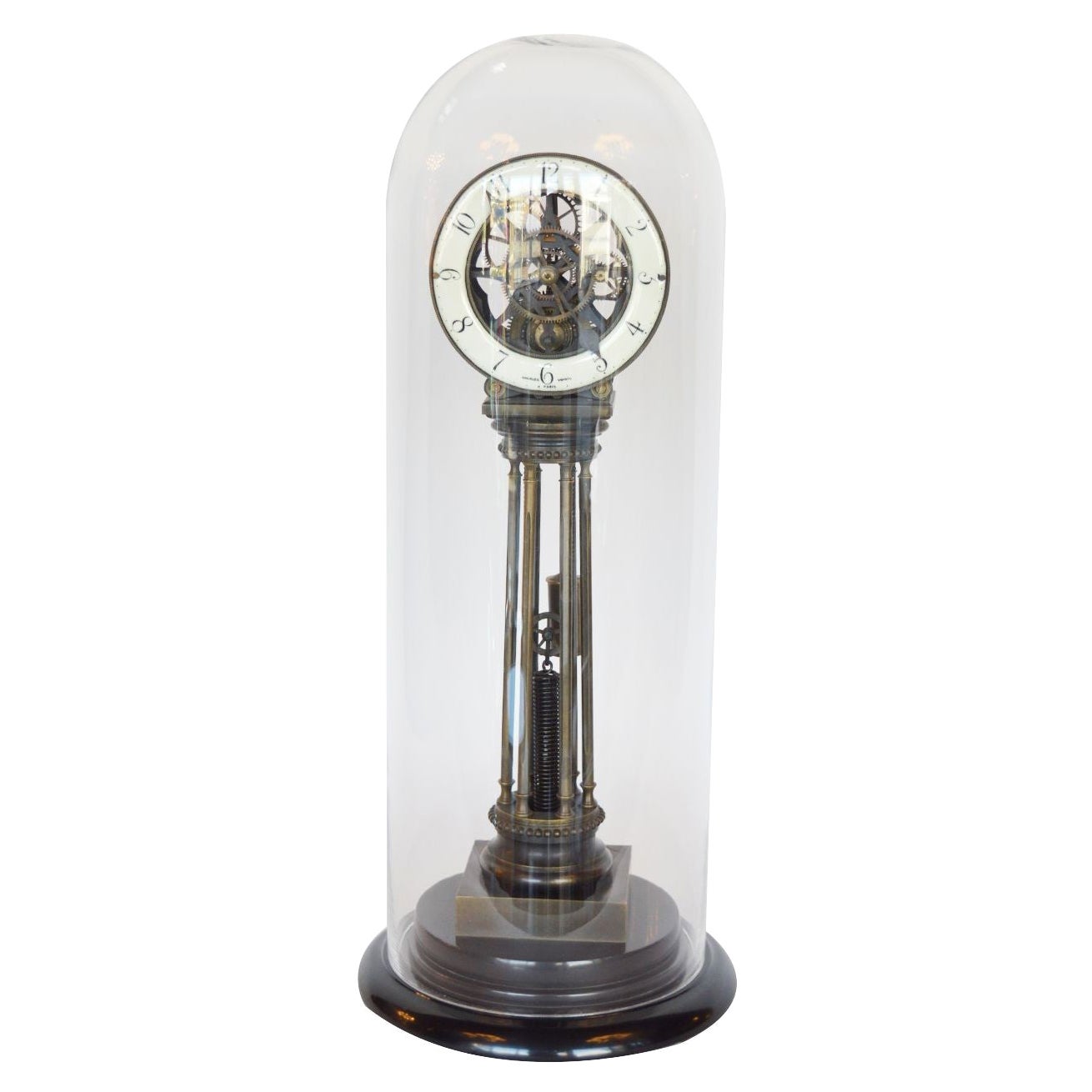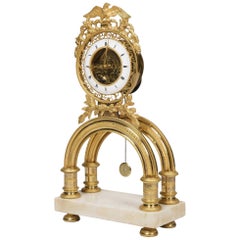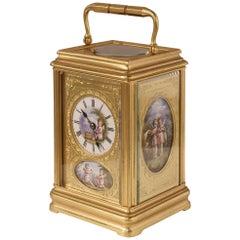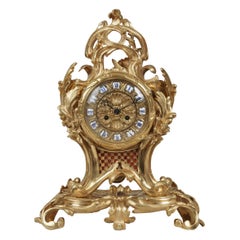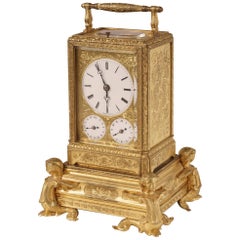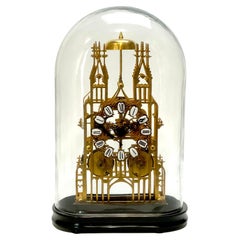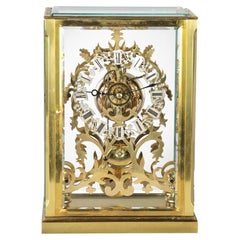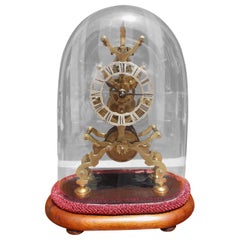Items Similar to Large 19th Century Gilt Skeleton Clock attributed to Evans of Handsworth
Want more images or videos?
Request additional images or videos from the seller
1 of 11
Large 19th Century Gilt Skeleton Clock attributed to Evans of Handsworth
$30,199.91
£22,500
€26,103.17
CA$42,432.39
A$46,525.83
CHF 24,322.40
MX$557,236.69
NOK 306,822.04
SEK 287,799.12
DKK 195,006.87
About the Item
An Exceptional and Large Skeleton Clock
Attributed to Evans of Handsworth
The multi-tiered pierced gilt brass frame of the skeleton clock after the design of the famous York Minster, the clock with a twin fusee movement with a half-deadbeat escapement striking the bell every half hour, and gong striking every hour, supported on an oval marble base and protected under a glass dome, the movement mounted between two silhouettes of the cathedral, with an identical tracery plate at the front portal mounted with a silvered dial denoting the hours in Roman numeral and blued steel fleur-de-lys hands.
English, circa 1855
Dimensions: H: 28 in / 71 cm W: 17 in / 43 cm D: 8.5 in / 22 cm
York Minster (minster meaning large church in Anglo-Saxon) is the largest Gothic cathedral in Western Europe. Its origins date back as far as 627 when a church was built for the baptism of Edwin, king of Northumbria. The church underwent various transformations and destructions and work began on the Minster as it is currently recognised in 1220 when Archbishop Gray decided to rebuild it on a scale to rival Canterbury. The South Transept was rebuilt between 1220 and 1250 and the North Transept was started and finished a few years after. Work on the nave began in 1291. Building was to continue for some 250 years, with the twin towers of the western front being completed in 1472. These are the towers shown on Victorian skeleton clocks.
Evans of Handsworth
W.F. Evans of Handsworth, near Birmingham, built his reputation during the 19th century as a masterful clockmaker specialising in intricate skeleton clocks. He exhibited at the 1851 Great Exhibition, where a "Gothic skeleton clock" was among his display.
- Attributed to:William F. Evans of Handsworth (Clockmaker)
- Dimensions:Height: 28 in (71.12 cm)Width: 17 in (43.18 cm)Depth: 8.5 in (21.59 cm)
- Materials and Techniques:
- Place of Origin:
- Period:
- Date of Manufacture:circa 1855
- Condition:Wear consistent with age and use. Clock is in working condition.
- Seller Location:London, GB
- Reference Number:Seller: 94351stDibs: LU954744277092
About the Seller
5.0
Recognized Seller
These prestigious sellers are industry leaders and represent the highest echelon for item quality and design.
Established in 1964
1stDibs seller since 2012
54 sales on 1stDibs
Typical response time: <1 hour
Associations
The British Antique Dealers' AssociationLAPADA - The Association of Arts & Antiques Dealers
- ShippingRetrieving quote...Shipping from: London, United Kingdom
- Return Policy
Authenticity Guarantee
In the unlikely event there’s an issue with an item’s authenticity, contact us within 1 year for a full refund. DetailsMoney-Back Guarantee
If your item is not as described, is damaged in transit, or does not arrive, contact us within 7 days for a full refund. Details24-Hour Cancellation
You have a 24-hour grace period in which to reconsider your purchase, with no questions asked.Vetted Professional Sellers
Our world-class sellers must adhere to strict standards for service and quality, maintaining the integrity of our listings.Price-Match Guarantee
If you find that a seller listed the same item for a lower price elsewhere, we’ll match it.Trusted Global Delivery
Our best-in-class carrier network provides specialized shipping options worldwide, including custom delivery.More From This Seller
View All19th Century French Skeleton Clock of Ormolu and Marble from Directoire Period
Located in London, GB
A symbolic skeleton clock from the French Directoire period.
A rectangular Carrara marble plinth with bronze toupie feet with knurled decoration supports an ormolu 'arc-de-ciel', wi...
Category
Antique Early 19th Century French Directoire Mantel Clocks
Materials
Carrara Marble, Ormolu, Bronze
19th Century Hand Painted, Engraved and Gilt Brass Carriage Clock
Located in London, GB
A fine carriage clock
The engraved gilt case rises from an ogee plinth, and is dressed with elliptical polychrome enameled plaques to the fascia and the sides, depicting children ...
Category
Antique Late 19th Century French Carriage Clocks and Travel Clocks
Materials
Brass
19th Century French Ormolu Mantle Clock in the Louis XV Rococo Style
Located in London, GB
An Elegant Mantle Clock
In the Louis XV Manner
The clock and its plinth executed in gilt bronze in a dynamic rococo style, rising from scrolling foliage, the dial in the shape of a ...
Category
Antique 19th Century French Louis XV Mantel Clocks
Materials
Ormolu, Bronze
19th Century French Petite Sonnerie Ormolu Carriage Clock by Grohé with Calendar
Located in London, GB
A Petit Sonnerie carriage clock by Grohe of Paris
The gilt bronze case comprehensively engraved, and having a retractable carrying handle; the lever movement driving the petit son...
Category
Antique 19th Century French Carriage Clocks and Travel Clocks
Materials
Ormolu, Brass, Bronze
Early Tripod Table Clock by Thomas Cole with Glass Dome
Located in London, GB
An extraordinary rustic tripod table clock
by Thomas Cole
Retailed by E. White of London
The circular green velvet-clad base supporting three equidistantly spaced brass imitation logs, from which the clock and its mechanism are suspended; housed within a brass bezel conformingly styled as naturalistic logs, the circular etched and engraved gilt dial with elegant blued steel hands, marked at 6 o'clock "E. White, 20 Cockspur St, London", having the hours marked in Roman numerals; the tapered two-tier movement has a six wheel train with five-spoke crossings between spotted plates, the upper section fixed by blued steel screws to the backplate, enclosing a Brocot-style deadbeat escapement incorporating rubies and train to the centre wheel, the pendulum of most unusual design styled as a lidded cauldron over a simulated fire. Complete with a glass dome and key. The front plate numbered “1637.”
London made, circa 1861
Thomas Cole, (1800-1864)
Son of Thomas Cole Snr, a Somerset clockmaker, his history and works are fully recorded in 'Thomas Cole & Victorian Clockmaking' by John B. Hawkins, published 1975, in Sydney. Known as a specialist in making decorative timepieces of the highest quality, Cole exhibited at the Great Exhibition at the Crystal Palace in 1851; he warranted an 'honourable mention' in the Paris Exhibition of 1855 and the London 1862 Exposition International, where he was awarded a medal for 'excellence of taste and design'.
Hawkins discuss Thomas Cole's tripod clocks...
Category
Antique 19th Century English Table Clocks and Desk Clocks
Materials
Brass, Ormolu, Bronze
19th Century French Gilt Bronze and Porcelain Clock in the Louis XVI Taste
By Raingo Frères
Located in London, GB
A mantle clock in the Louis XVI taste by Raingo Freres, Paris
Constructed in gilt bronze, and dressed with Bleu Celeste framed porcelain panels, decorated in polychromes, in the '...
Category
Antique Late 19th Century French Louis XVI Mantel Clocks
Materials
Ormolu, Bronze
You May Also Like
Large English Style Cathedral Crown Escapement Fusee Striking Skeleton Clock
Located in Danville, CA
Large English Style Cathedral Crown Escapement Fusee Striking Skeleton Clock
Here is a very nice looking English style Cathedral form skeleton clock. It sits on a wooden base and pr...
Category
Late 20th Century Table Clocks and Desk Clocks
Materials
Brass
English Late 19th Century Skeleton Clock with Oval Glass Dome
Located in Los Angeles, CA
English Late 19th Century Skeleton Clock Protected by a Glass Dome.
Category
Antique 1890s English Other Table Clocks and Desk Clocks
Materials
Brass
A very fine mid Victorian skeleton clock by Johnston of London
By John Johnston
Located in Lymington, Hampshire
A very fine mid Victorian skeleton clock by Johnston of London, of large rectangular form comprising two openwork arabesque panels parti A very fine mid Victorian skeleton clock by Johnston of London, of large rectangular form comprising two openwork arabesque panels partially shielding the fusée bell striking movement, the polished scroll frame raised on shaped turned pillars, the foliate scrolled silvered and engraved dial with Roman numerals joined with delicate thistle motifs, housed in its integrated glazed brass case applied with a silvered maker’s labels stating ‘Johnston, 2 Elm Street...
Category
Antique Mid-19th Century English Victorian Mantel Clocks
Materials
Brass
English Brass and Polished Steel Skeleton Clock Under Glass Dome Webber, C. 1870
By Webber
Located in Charleston, SC
English brass skeleton clock under original glass dome with a polished steel roman numeral dial, fuse chain movement, and affixed to an oval carved wood felt base with four bun feet....
Category
Antique 1870s English Victorian Mantel Clocks
Materials
Brass, Steel
Early Victorian English Skeleton Clock by Joseph Watson & Son, Cambridge
Located in Norwich, GB
Early Victorian Skeleton Clock by Joseph Watson & Son, Cambridge
Eight day chain fusee movement with fine wheelwork set between steeple sh...
Category
Antique 1840s English Early Victorian Mantel Clocks
Materials
Brass
French 18th Century Skeleton Clock by Charles Voisin
Located in Los Angeles, CA
French 18th century Skeleton clock with oval glass panel by Charles Voisin.
Category
Antique 18th Century French Table Clocks and Desk Clocks
Materials
Brass
More Ways To Browse
1851 Exhibition
Used Baptismal
1851 Great Exhibition
Gothic Cathedral
Tower Clock
Large Antique Desk Desks
Large Desk Antique Furniture
Antique Tower Clock
Antique Skeleton Clock
Antique Clocks York
York Minster
Cathedral Plates
Victorian Skeleton Clock
1930s Antique Clocks
Antique Ball Clocks
Art Deco Green Clock
Art Deco Lecoultre Clock
Car Clocks
